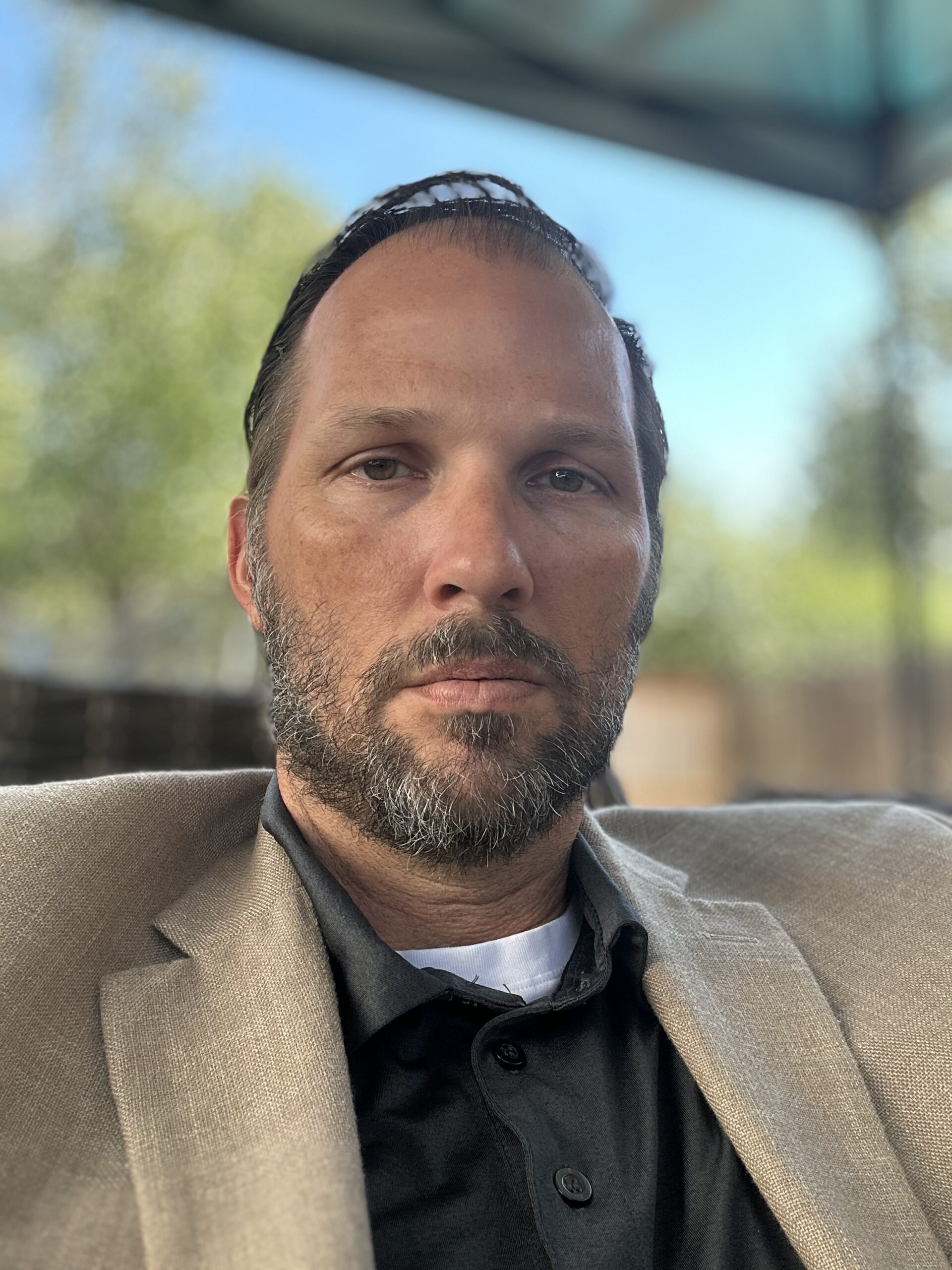The Sunset of FARC and the Execution of a Comprehensive Counterinsurgency Program
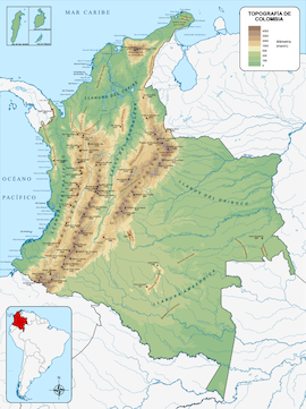
Perspective: The Sunset of FARC and the Execution of a Comprehensive Counterinsurgency Program
Alejandro Duran
Las Fuerzas Armadas Revolucionarias de Colombia or FARC have their origin in a period of continuous and widespread political, social, and economic unrest that is commonly known as “La Violencia” in contemporary Colombian History. Identifying the underlying causes behind this important historical period is crucial to our understanding of the motivation behind the rise of the longest-lived insurgency in the western hemisphere.
La Violencia (1946–1958) as is commonly known, has many pillars: Political confrontation, mainly attributed to a long lived and bitter power struggle between the liberal and conservative parties. Religious: a strong catholic church opposing liberal ideas that were taking hold in the country, mainly of communist origin. Economic: strife for the ownership and use of land, industrialization process, and (once more) the surge of the communist ideology in the country.
On the economic front, the industrialization process was crucial. The influence of an international economist, Lauchlin Currie, generated changes in the country that would continue to fuel the social inequality struggle. Sponsored by the World Bank on a mission to Colombia, Currie favored the transition to a predominantly urbanized and industrialized Colombia where working the land was not as important as the promotion of factory work. Under this view, any type of land reform was of little interest to the government, though it was a what many Colombians, who made a living out of agriculture, vehemently pursued. Despite the economic growth sparked by the industrialization process, which was aided by the post WW II global development, and a rise in international coffee prices, the political and socio-economic divisions that kept the country in a state of perpetual conflict only continued to deepen.
Government-sponsored repression was met with an ever-increasing diverse base of resistance: farm workers, small business owners, transportation workers, etc. While the liberal party tried to promote peaceful movements, it could hardly contain the increasing tension that had been building for years. One event seems to have broken the proverbial camel’s back: the assassination of the liberal party’s main leader—Jorge Eliécer Gaitán on 9 April 1948. This fateful event took place only two months after Gaitán had led a large protest in Bogotá where he denounced the violent ways of the conservative government. During his speech, Gaitán, warned the governing power about the restive masses that could rise should pressure continued to be applied to pacify them.
Gaitán’s assassination was, allegedly, the catalyst for an episode of intense violence known as “El Bogotazo,” which brought about widespread destruction in the country’s capital.[1]
As tensions continued to rise in Colombia during the first half of the twentieth century, the basis for a large, organized insurgency started to take shape. Colombia, being a country with a geography rich in mountainous, impenetrable terrain, and an intense period social unrest, became highly conducive to the formation of insurgent movements. This is how, in the 1960s FARC organizes and decides to start its long-lived struggle as the main Marxist nemesis of the Colombian state.

Map of Colombia showing its three main mountain ranges. Wikimedia Commons (CC BY-SA 4.0)
FARC’s original mission was intended to be one of social justice and vindication for poor farm workers, who were at the mercy of powerful landowners and aggressive economic policies from conservative governments that provided little or no support for their development.[2]
FARC had a well-defined Marxist ideology. According to Britannica, FARC supported “a redistribution of wealth from the wealthy to the poor and opposes the influence that multinational corporations and foreign governments (particularly the United States) have had on Colombia.”[3] FARC’s political violence was initially directed at the government and their supporters. However, with time, FARC adopted the drug trafficking business, and veered its actions toward the growth and protection of its illegal drug production, processing, and trafficking in and out of the Colombian territory.[4] Although they have always claimed to abide by their social justice principles, it would not be unreasonable to conclude that, in practice, they have been fighting the Colombian state to keep their drug trafficking operations, more so than attempting to procure social justice reforms aimed to help Colombia’s poorest. FARC’s involvement with drug trafficking weakened their political claims. However, despite this factor, FARC was able to secure control of large swaths of territory for prolonged periods of time.
FARC’s long history of war against the state has been significantly aided and countered by the inclusion of Important International actors: the United States, which has helped the Colombian Government by providing funding, policy, and military advice; Spain, France, and Switzerland, which have aided conversations for hostage releases; Brazil which has cooperated with Colombia in border security; Cuba which facilitated Peace talks between FARC and the Santos Administration in the early 2000s and lastly: Venezuela, Ecuador, and Panama, which were providing different levels of support to FARC (shelter, political, and military support) specially during the first decade of the XXI century.[5]
Many leaders have carried out FARCs long fight against Colombia, among the most notable are Timochenko, Iván Márquez, Matthew Rodriguez, Joaquín Gómez, Pablo Catatumbo, Mauricio Jaramillo, Alfonso Cano, and Manuel Marulanda most of which are now dead as the result of their confrontation with Colombia’s security forces. The timeline below is a good summary of FARC’s life cycle since its inception.
FARC Timeline:
- May 1964: Rebel leader Manuel Marulanda, alias “Sureshot,” founds the Revolutionary Armed Forces of Colombia, known as FARC.
- 7 August1982: Government of President Belisario Betancur starts peace negotiations with FARC.
- June 1987: Tenuous-at-best cease-fire wounded when rebels attack kills 25 soldiers in southern Colombia.
- April 1991: FARC, along with fellow rebel groups National Liberation Army and Popular Liberation Army, sit down for talks with government delegates in Venezuela. Talks are later moved to Mexico.
- October 1992: Negotiations end with no agreement.
- August 1998: President Andrés Pastrana announces new peace effort with FARC. Sets up Switzerland-sized demilitarized zone in southern Colombia where talks can be held.
- 20 February 2002: Rebels hijack plane and take captive a senator who is member of peace commission. Pastrana breaks off negotiations.[6]
Since its inception, FARC has committed a series of acts of extreme violence, not only against the Colombian state, but also against the civilian population. Some of the most notorious incidents, of recent data, that illustrate FARC’s willingness to inflict extreme pain on the Colombian people, list the massacre of Bojayá in 2002, and the attack on Bogotá’s Social Club “El Nogal” in 2003. In both attacks tens of innocent people were targeted. In the case of Bojayá, 79 people died: 41 women and 38 men, most of them younger than 18 years old. Among the fatal victims, 2 unborn babies died, and 1 baby was born and killed during the incident.
The Bojayá massacre took place during a heated confrontation between FARC and a detachment of the paramilitary group Autodefensas Unidas de Colombia (AUC). Both factions had been engaged in combat for days, in that region, which led people to take refuge in worship places, thinking that the combatants would not harm religious buildings. Unfortunately, on the night of 2 May 2002, a mortar launched pipe explosive, fired by FARC, entered the “Bellavista” church, where more than 300 people had been taking refuge, and exploded causing 79 fatal victims.[7]
On 7 February 2003, a FARC operated car-bomb exploded inside Bogotá’s Club El Nogal. The car contained 200 Kg (440 lbs.) of explosive material and was set off inside the indoor parking garage of the popular club. The explosion was responsible for 36 fatal victims, 198 wounded, and the destruction of the building that housed the club.[8] FARC later admitted that they had targeted the club because it was a place where paramilitary groups help meetings with representatives of the Colombian State.[9]
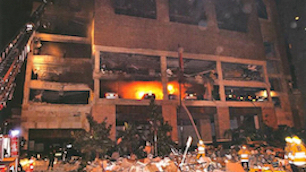
The attack on Club El Nogal (Photo: Archivo de la Presidencia de la República).
These attacks took place at what was arguably the height of FARC’s strength. By 2002, FARC had an estimated 20,000 active fighters in their ranks.[10]
FARC Timeline (Continued):
- December 2004: Undercover Colombian agents capture Rodrigo Granda, considered FARC’s “foreign minister,” in Venezuela and bring him to Colombia.
- 16 August 2007: Venezuelan President Hugo Chavez offers to mediate between FARC and Colombian President Alvaro Uribe. Effort collapses a few months later.
- 26 March 2008: Top FARC leader Marulanda dies of natural causes after more than four decades fighting government.
- 22 September 2010: No. 2 FARC commander and top military strategist Jorge Briceño, alias Mono Jojoy, killed by air strike.[11]
After decades of ineffective counter insurgency strategies, a strong leader with powerful internal and external support was able to change Colombia’s fight against FARC for good.
Colombia’s most successful COIN campaign, against FARC, took place mostly during both administrations of President Alvaro Uribe Velez (2002–2010). President Uribe implemented a comprehensive plan labeled Policy for the Consolidation of Democratic Security (PCSD). The policy had five specific strategic objectives:
- To Consolidate territorial control and strengthen the rule of law across the entire national territory.
- To protect the public and hold on to the strategic initiative against all threats to citizen security.
- To drastically raise the cost of trafficking drugs in Colombia.
- To keep the public security forces modern and effective, with a high level of legitimacy based on public confidence and support.
- To maintain the downward trend in all crime rates in the country’s urban centers.[12]
According to a report published by Colombia’s Defense Ministry, between 2002 and 2006 there was a significant reduction in the number of homicides by 40%, during the same period, kidnappings (for extortion purposes) declined in 83%, and terrorist attacks decreased by 61%.[13] These are some of the indicators used by the Colombian State to gauge the success of their counterinsurgency (COIN) effort against FARC. While not all homicides, kidnappings, and attacks could be attributed to the insurgents, FARC did account for most of them. In consequence, these sharp decreases were consistent with the setbacks being experienced by FARC as a direct result of the COIN strategy implemented by the State.
FARC was not the only subversive group affected by the COIN strategy. Other groups of interest, such as the Autodefensas Unidas de Colombia (AUC), a paramilitary group that originated as a response to the communist guerrilla threat and Colombia’s inability to provide security to the population)was also affected. The far-reaching effects of the COIN strategy eroded the need for such paramilitary groups and led to their eventual demobilization. The following figures (Figures 1–5), contained in an official report from Colombia’s Defense Ministry from 2008, illustrate the palpable impact the new COIN strategy had on the decrease of levels of violence to which the Colombian people were being subjected.
Terrorist attacks:
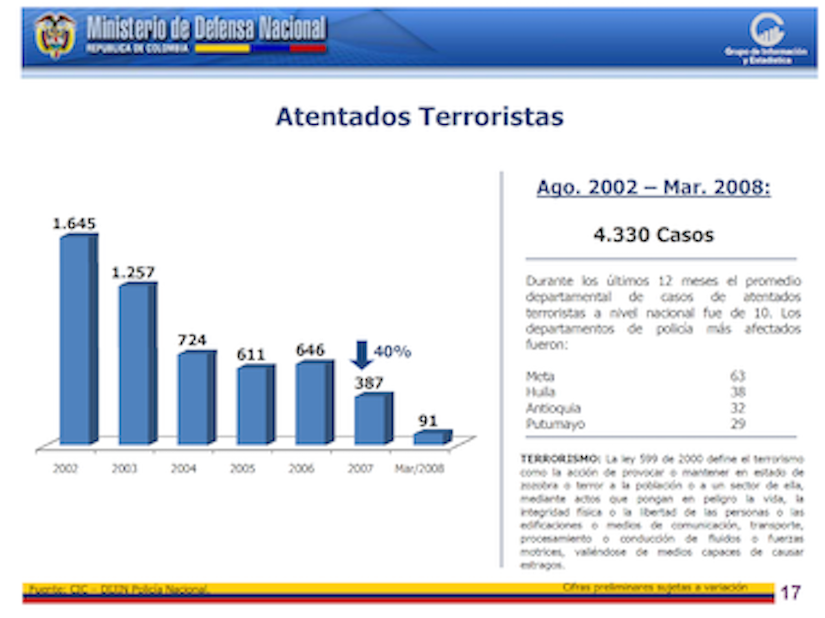
Figure 1. Colombia Defense Minister’s March 2008 Democratic security consolidation policy achievement report showing the decrease in terrorist attacks from August 2002 through March 2008.[14]
Subversive Actions:
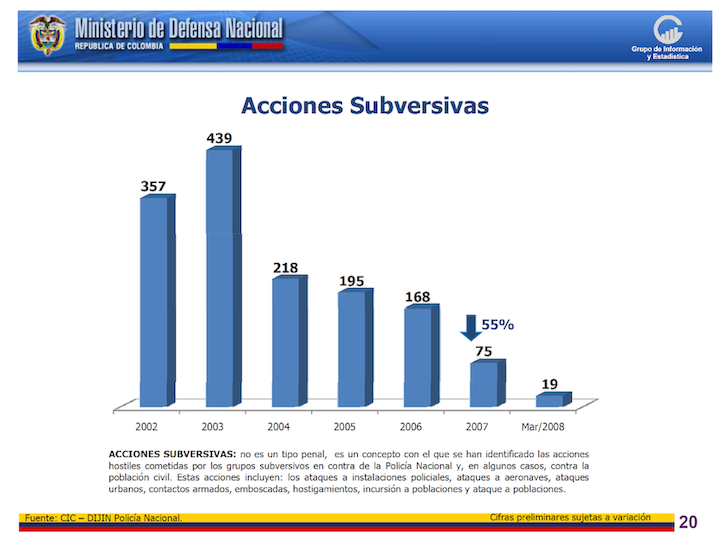
Figure 2. Colombia Defense Minister’s March 2008 Democratic security consolidation policy achievement report showing the decrease in subversive actions from August 2002 through March 2008.[15]
Extortion motivated kidnappings:
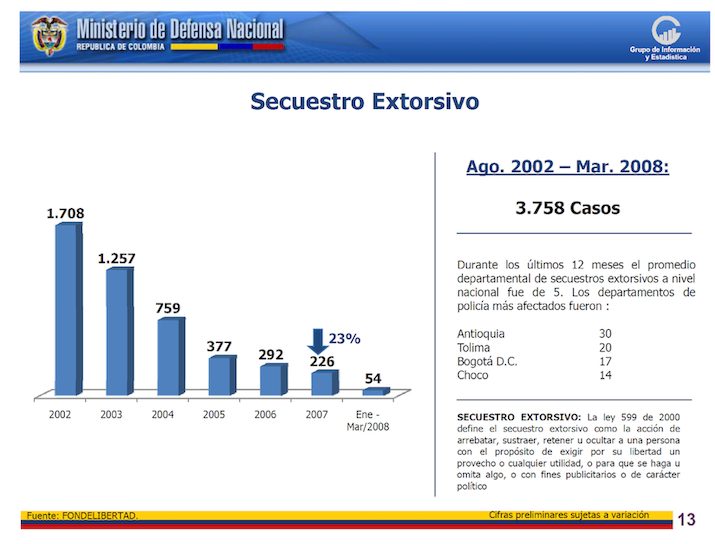
Figure 3. Colombia Defense Minister’s March 2008 Democratic security consolidation policy achievement report showing the decrease in extortion motivated kidnappings from August 2002 through March 2008.[16]
Oil Pipeline explosions:
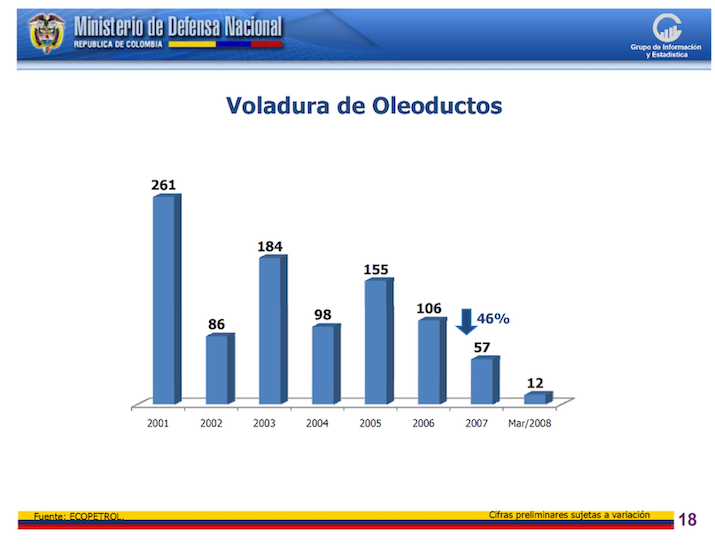
Figure 4. Colombia Defense Minister’s March 2008 Democratic security consolidation policy achievement report showing the decrease in attacks to oil pipelines using explosives from 2001 through March 2008.[17]
Powerline Explosions:
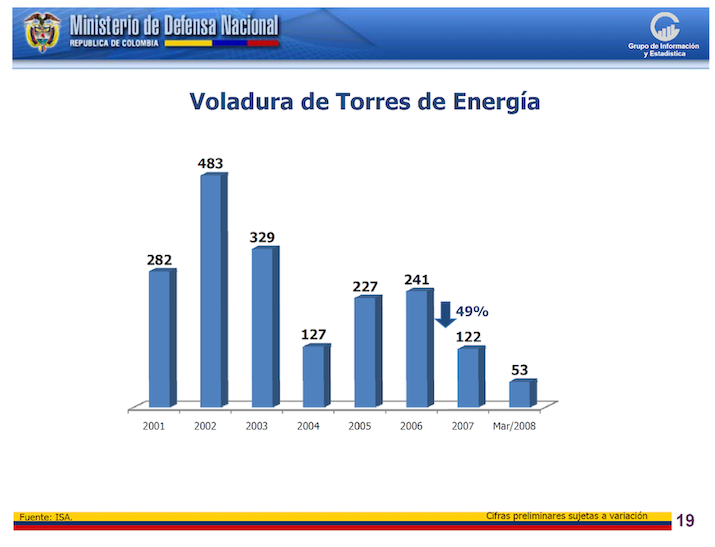
Figure 5. Colombia Defense Minister’s March 2008 Democratic security consolidation policy achievement report showing the decrease in attacks to powerlines using explosives from 2001 through March 2008.[18]
Prior to President Uribe’s PCSD, Colombia’s COIN strategy consisted mostly of the use of force. In 1988, the Journal of Interamerican Studies and World Affairs published an article by Marc Chernick, which aptly summarized the state’s COIN strategy up to the mid-eighties of the XX century:
Colombia’s peace process, initiated dur government of Conservative President Belisario Betancur 1986), was a recognition of the limits, indeed the failure military solution to the maintenance of public order. Under previous governments, repressive policies had proven incapable of distinguishing between armed insurgency and legal dissent.[19]
The success of President Uribe’s new COIN strategy can be better understood with the help of academic work that has studied the success and failure of COIN campaigns throughout recent history. Professor Anthony James Joes, author of the book Resisting Rebellion: The History and Politics of Counterinsurgency,[20] offers a series of elements that, in his view, a successful counterinsurgency strategy should have. Throughout his book, Professor Joes elaborates on aspects beyond the use of force to conduct successful COIN operations. According to Joes, when countering insurgencies, special attention must be dispensed to the reasons that motivated their existence, which tend to be of social and political origin in many cases. Addressing these causes requires the thorough understanding of the characteristics of the affected population, terrain considerations, external factors, etc. which will allow for the crafting of a comprehensive strategy that will simultaneously address all dimensions of the conflict, to produce a favorable and stable result. As such, the commitment of an adequate level of resources is paramount to provide the COIN strategy with a feasible path to success.
Colombia’s COIN strategy from 2002 onwards displays several of these elements, listed by Joes, being used in conjunction, which helps explain the success of the strategy in seriously degrading FARC during the first decade of the XXI century. The most relevant elements, identified in Colombia’s PCSD, can be listed under to broad categories:
Strategic Approach:
- Provide a peaceful path to change
- Commit Sufficient Resources
- Isolate the Conflict Area
Operational approach:
- Display Rectitude
- Emphasize Intelligence
- Divide Insurgent Leaders from their Followers
- Offer Amnesty
- Drain disturbed areas of firearms
- Disrupt insurgent food supplies.[21]
The following review will focus on a few of the most salient elements of President Uribe’s PCSD.
Commit Sufficient Resources
Colombia moved decisively toward the investment of considerable resources to bolster its posture in the conflict. Though a comprehensive COIN strategy most focus on factors other than force, the security element does not cease to be of great importance. In consequence, resource investment must be proportional to the size of the engagement, which can be determined by the size of the Area of Operations, the size of the enemy force, their resources, and the civilian considerations present in the field:
To accomplish the goals of the PCSD, the Uribe government intensified the process of expanding and strengthening the Colombian security forces, which increased from 158,000 military and 104,000 police personnel in 2002 to 267,000 military and 137,000 police personnel in 2009, representing an overall increase of almost 50 percent. Largely through U.S. assistance, the Colombian armed forces were provided with enhanced mobility and intelligence capabilities. As a result, the Colombian armed forces have developed the capability to conduct operations in remote areas in a sustained manner and to hold areas previously controlled by the guerrillas. By 2004, the Colombian government was able to meet its goal of establishing a presence in every one of the country’s 1,098 municipalities, a critical component of the territorial recovery strategy.[22]
Divide Insurgents from Followers
The Colombian Government’s systematic ability to drive FARC from longstanding strongholds to establish and maintain a strong presence in them, was key in depriving FARC from population support. Assertive Government action, to fill the authority void left by the displacement of the guerrilla in the contested areas, helped the strengthening of the State’s position as trusted authority to begin the recovery, in all aspects, of the liberated areas. As the Government advanced, financial aid poured into the freed territories, new infrastructure was built, and security was bolstered.
Offer Amnesty
Demobilization was incentivized, in part, by the existence of a Peace and Justice act that set eight-year ceilings on prison terms for insurgents found guilty of criminal offenses and provided rehabilitation opportunities for an eventual reinsertion into the broader society.[23]
External Assistance to the Government
The United States’ assistance to the Colombian Government, in terms of military training, military hardware, and funding was key in allowing the state to seize the momentum of the conflict and take the fight to the insurgents in new ways. While the US was not directly involved in kinetic operations, its advice provided considerable advantage to the Colombian military.
In addition to factors that favored the Colombian state, a few other were on the side of the insurgents.[24]
Foreign Support to the Guerrilla
There are compelling indications of the existence of various levels of Support that were provided to FARC, by the Hugo Chavez’s administration (Venezuela). One of the most notable pieces of evidence of this support came after the Colombian Army captured intelligence material contained in the computer of Raul Reyes, after the FARC commander was killed in an operation on Ecuadorian territory:
“The Reyes files contained numerous examples of active and passive support for FARC: since the early 2000s, the Venezuelan government had funded an office in Caracas and allowed the group to “use Venezuelan territory for refuge, cross-border operations and political activity;” had enlisted the help of both Ramón Rodríguez Chacín, the second most important member of Venezuela’s National Intelligence Directorate (Disip), and Freddy Bernal, the former mayor of the municipality of Libertador, in contacting and sustaining relations with FARC; had permitted senior officials such as Rodrigo Granda, Marin Arango (“Iván Marquez”), and Rodrigo London “Timochenko” Echeverry to move freely in Venezuela; had promised surface-to-air missile systems and man-portable air defense systems (MANPADS); and had offered over $300 million in monetary assistance. Only $50 million of the promised funds had been paid by 2007, spurring a remark from Manuel Marulanda that “a bird in the hand is worth two in the bush.”[25]
However, despite the support received from Venezuela, the leveraging of porous borders in Ecuador and Panama, and a significant amount of funding from drug trafficking, FARC was unable to keep up with the comprehensive COIN strategy implemented by President Uribe’s two terms in power. The death, in rapid succession, of several FARC’s most powerful leaders, arguably, dealt a big blow to the weakened organization, which by 2016 were willing to negotiate a peace treaty with the Colombian Government. The FARC experienced a dramatic loss of territory, because of the PCSD, between 2002 and 2012.[26]
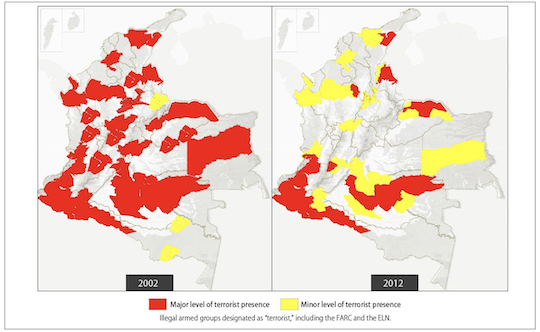
Map of Colombia showing the change in FARC occupied territory from 2002-2012 (Government of Colombia, 2013 as edited by Congressional Research Service. 2016)
In 2016, after many decades of intense conflict, Colombia and FARC signed a peace accord that would end FARC’s movement, as insurgency, and give them an opportunity to become a peaceful Political movement. The accord had several goals: end the war, truth, justice, and reparation for victims, address the drug trafficking that financed the movement, betterment of opportunities for land ownership and production, the lack of which was a great catalyst for the origination of the insurgency in the 1960s, more democratic participation, and the execution of the final accord.
The agreement asked for FARC to cease military operations and give up their weapons to the United Nations. In exchange, there would be a special justice program that would incentivize former guerrilla members to confess crimes and provide intelligence that would lead to the proper assessment of reparations for victims. Valuable information leading to the apprehension of insurgent leaders, responsible for the commission of heinous crimes, would be rewarded with shorter prison sentences. The accord also sought to breach the gap between urban and rural societies; as part of this initiative, new investment opportunities would be made available to rural workers to own and work their land. In addition, new infrastructure would be built to allow for the proper development of the poorest areas of the country.
To address the drug trafficking and production, that was incentivized by the guerrilla, a program to help farmers substitute coca crops for new legal products would put in place. FARC would commit itself to severe ties with the drug trafficking business.
Unarmed FARC would be allowed to participate in the Colombian democratic process as a legitimate political movement.[27]
However, the accord generated a strong rejection from over 50% of Colombian voters, when consulted about the implementation of the treaty. The main reason for the rejection, was the concessions made to former FARC members, by the special Justice designed for the agreement. According to an investigation conducted by the BBC, most Colombians did not consent of the agreement because:
“Under the agreement, special courts would have been created to try crimes committed during the conflict. Those who confessed to their crimes would have been given more lenient sentences and would have avoided serving any time in conventional prisons. This, for many Colombians, was one step too far. They also balked at the government’s plan to pay demobilized Farc rebels a monthly stipend and to offer those wanting to start a business financial help.
“No” voters said this amounted to a reward for criminal behavior while honest citizens were left to struggle financially. Many also said that they simply did not trust the rebels to keep their promise to lay down arms for good.
They pointed to previous failed peace negotiations when the rebels took advantage of a lull in fighting to regroup and rearm as evidence that the Farc had broken their word before. Others were unhappy that under the agreement, the Farc would be guaranteed 10 seats in the Colombian Congress in the 2018 and 2022 elections. They said this would give the newly created party an unfair advantage.”[28]
Despite the rejection, President Santos decided to move forward with the agreement and the treaty was implemented.
Today, there are still smaller factions of FARC who decided not to adhere to the agreement, however, these are far smaller than FARC was originally and do not represent the same level of threat to the Colombian state as its far larger predecessor did. Time is still needed to gauge the true impact of the accord. Nonetheless, it is important to note that the peace process, as polemic as it was, brought to a decisive halt the largest operations of an insurgency that had been at arms for over six decades with the Colombian Government. The peace process was only possible after the significant progress Colombia was able to achieve in its war against FARC once a well-planned and implemented COIN strategy was executed in the early 2000s. Despite the imperfections of the agreed peace, the systematic disarticulation of a once very powerful guerrilla, seems to have significantly reduced the level of violence Colombians had experienced for decades, and that barely two decades ago seemed to have no end in sight.
More work still needs to be done as other, much smaller; insurgencies continue to exist in Colombia. The continuation of a COIN strategy that is flexible and sensitive to the dynamics of the Colombian society, is the south American country’s best bet to continue to address the motivations that continue to fuel the existence of these violent groups throughout the country.
Endnotes
[1] Antonio Caballero, “Historia de Colombiay sus oligarquías (1498–2017).” Bogotá: Biblioteca Nacional de Colombia (n.d.), https://bibliotecanacional.gov.co/es-co/proyectos-digitales/historia-de-colombia/libro/index.html.
[2] Ibid.
[3] Britannica, The Editors of Encyclopedia. “FARC.” Encyclopedia Britannica. 28 July 2023, https://www.britannica.com/topic/FARC.
[4] “Como fue el inicio de las FARC?” Semana. 29 August 2019, https://www.semana.com/educacion/articulo/la-historia-de-las-farc/467972/.
[5] Angel Rabasa, John Gordon IV, Peter Chalk, Christopher S. Chivvis, Audra K. Grant, K. Scott McMahon, Laurel E. Miller, Marco Overhaus, and Stephanie Pezard, From Insurgency to Stability: Volume I: Key Capabilities and Practices. Santa Monica: RAND Corporation, 2011: https://www.rand.org/pubs/monographs/MG1111z1.html. See also, Angel Rabasa, John Gordon IV, Peter Chalk, Audra K. Grant, K. Scott McMahon, Stephanie Pezard, Caroline R. Milne, David Ucko, and S. Rebecca Zimmerman, From Insurgency to Stability: Volume II: Insights from Selected Case Studies. Santa Monica, CA: RAND Corporation, 2011: https://www.rand.org/pubs/monographs/MG1111z2.html.
[6] “A Timeline of Colombia’s 55-year rebel conflict.” Associated Press, AP News. 29 August 2019, https://apnews.com/article/79af91d139ae41a2abd06fdcdf86a7da.
[7] “Bojayá, la población donde las FARC cometieron una de sus peores masacres y que votó abrumadoramente por el Sí.” BBC News Mundo. 3 October 2016, https://www.bbc.com/mundo/noticias-america-latina-37541772.
[8] Jeniffer Tatiana Munevar, “Atentado contra el Club El Nogal: así fue la tragedia hace 20 años.” Infobae. 7 February 2023, https://www.infobae.com/colombia/2023/02/07/atentado-contra-el-club-el-nogal-asi-fue-la-tragedia-hace-20-anos/.
[9] Juan David López, “Confesiones de las Farc arrancan por El Nogal.” El Tiempo. 13 February 2018, https://www.eltiempo.com/politica/proceso-de-paz/farc-confiesan-por-que-atacaron-el-club-el-nogal-182314.
[10] “Who are the Farc? BBC News. 24 November 2016, https://www.bbc.com/news/world-latin-america-36605769.
[11] Op. Cit., AP Timeline at Note 6.
[12] “Política de Consolidación de la Seguridad Democrática (PCSD).” Bogotá: Ministerio de Defensa Nacional, República de Colombia. 2007, https://pdba.georgetown.edu/Security/citizensecurity/Colombia/politicas/consolidacion.pdf.
[13] Ibid.
[14] Juan Manuel Santos Calderón, Ministro de Defensa Nacional, “Logros de la Política de Consolidación de da Seguridad Democrática – PCSD.” Bogotá: Ministerio de Defensa Nacional, República de Colombia. March 2008, https://www.mindefensa.gov.co/irj/go/km/docs/Mindefensa/Documentos/descargas/Resultados_Operacionales_2/resultadosenero-marzo.pdf; p. 17.
[15] Ibid., p. 20.
[16] Ibid., p. 13.
[17] Ibid., p. 18.
[18] Ibid., p. 19.
[19] Michael Chernick, “Negotiated Settlement to Armed Conflict: Lessons from the Colombian Peace Process.” Journal of Interamerican Studies and World Affairs. Vol. 30, no. 4, Winter 1988–1989, pp.53–88, https://www.jstor.org/stable/166057?origin=crossref.
[20] Anthony James Joes, Resisting Rebellion The History and Politics of Counterinsurgency. Lexington: The University Press of Kentucky.
[21] Ibid.
[22] Op. Cit., Rabassa at Note 5, Vol. 2, p. 46.
[23] Op. Cit., Rabassa at Note 5.
[24] Ibid.
[25] Miguel Goncalves, “Conditional Convenience: Venezuelan Support for FARC since Hugo Chávez,” The Yale Review of International Studies, January 2014, https://www.amazon.com/Resisting-Rebellion-History-Politics-Counterinsurgency/dp/081319170X.
[26] See “Colombia’s Peace Process Through 2016,” Washington, DC: Congressional Research Service (RS4982), 31 December 2016, https://crsreports.congress.gov/product/pdf/R/R42982/16; p. 8.
[27] “ABC del Acuerdo Final: Cartilla Pedagógica: ACUERDOFINAL para la TERMINACIÓN DEL CONFLICTO y la construcción de una PAZ estable y duradera.” Bogotá: Cancilleria de la Republica de Colombia. 2016, https://www.cancilleria.gov.co/sites/default/files/cartillaabcdelacuerdofinal2.pdf.
[28]“Colombia referendum: Voters reject Farc peace deal.” BBC News. 3 October 2016, https://www.bbc.com/news/world-latin-america-37537252,







